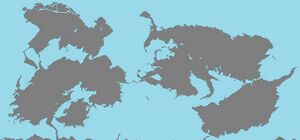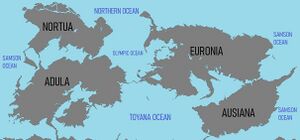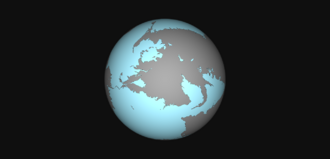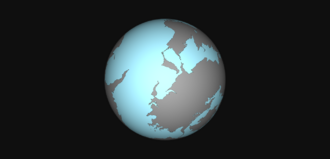Iearth: Difference between revisions
No edit summary |
(Don't remove the Mod Review tag unless you actually remove the plagiarism.) |
||
| Line 1: | Line 1: | ||
{{WIP}} | {{WIP}} | ||
{{ModReview|Glitter|Plagiarism from the {{wp|Earth}} article}} | |||
{{Infobox planet | {{Infobox planet | ||
| name = Iearth | | name = Iearth | ||
Revision as of 17:05, 17 April 2020
This article is incomplete because it is pending further input from participants, or it is a work-in-progress by one author. Please comment on this article's talk page to share your input, comments and questions. Note: To contribute to this article, you may need to seek help from the author(s) of this page. |
The reason given is:
Last edit by: Glitter (talk · contrib) · Last edited on Fri, 17 Apr 2020 17:05:08 +0000
 Photograph of Iearth, taken by the Zamastanian Zian-2B Satellite | |
| Orbital characteristics | |
|---|---|
| 149598023 km (92955902 mi; 1.00000102 AU) | |
| Eccentricity | 0.0167086 |
| 365.256363004 d (1.00001742096 yr) | |
| Satellite of | Sun |
| Physical characteristics | |
Mean radius | 6371.0 km (3958.8 mi) |
| 510072000 km2 (196940000 sq mi) | |
| Volume | 1.08321×1012 km3 (2.59876×1011 cu mi) |
| Mass | 5.97237×1024 kg (1.31668×1025 lb) |
Mean density | 5.514 g/cm3 (0.1992 lb/cu in) |
| 9.807 m/s2 (1 g; 32.18 ft/s2) | |
| 11.186 km/s (40270 km/h; 25020 mph) | |
| 23.4392811° | |
| Atmosphere | |
Surface pressure | 1 atm (100 kPa) |
Iearth, also known as Earth, is the third planet from the Sun, home to many countries and international organizations such as the Coalition of Crown Albatross. It is the only planet in the cosmos known to accomodate life. Scientific analysis and radiometric determination have concluded that Iearth developed over 4 billion years ago. The Iearth rotates around the Sun in 365 and ¼ days, a period commonly accepted as Iearth year. The seasons are formed by the inclination of the rotational axis in the direction of the orbital surface.
The Moon is an astronomical body that orbits planet Iearth. It is Iearth's only stable natural satellite. The gravitational relation between Iearth and the Moon has many effects: it causes oceanic tides, stabilisation of the planetary axis, and gradual reduction of Iearth's spin. Iearth is the most solid planet in the Solar System, and the largest of the Eurrestrial planets.
The world contains a large variety of nations where the people speak many languages. According to the latest census date the Iearth is home to about 10 billion human beings.
History
See also: History of Iearth
Formation
The oldest material found in the Solar System is dated to 4.5672±0.0006 billion years ago (Bya). By 4.54±0.04 Bya the primordial Iearth had formed. The bodies in the Solar System formed and evolved with the Sun. In theory, a solar nebula partitions a volume out of a molecular cloud by gravitational collapse, which begins to spin and flatten into a circumstellar disk, and then the planets grow out of that disk with the Sun. A nebula contains gas, ice grains, and dust (including primordial nuclides). According to nebular theory, planetesimals formed by accretion, with the primordial Iearth taking 10–20 million years (Mys) to form.
Geological history
Iearth's atmosphere and oceans were formed by volcanic activity and outgassing. Water vapor from these sources condensed into the oceans, augmented by water and ice from asteroids, protoplanets, and comets. In this model, atmospheric "greenhouse gases" kept the oceans from freezing when the newly forming Sun had only 70% of its current luminosity. By 3.5 Bya, Iearth's magnetic field was established, which helped prevent the atmosphere from being stripped away by the solar wind.
A crust formed when the molten outer layer of Iearth cooled to form a solid. The two models that explain land mass propose either a steady growth to the present-day forms or, more likely, a rapid growth early in Iearth history followed by a long-term steady continental area. Continents formed by plate tectonics, a process ultimately driven by the continuous loss of heat from Iearth's interior. Over the period of hundreds of millions of years, the supercontinents have assembled and broken apart.
The present pattern of ice ages began about 40 Mya, and then intensified during the Pleistocene about 3 Mya. High-latitude regions have since undergone repeated cycles of glaciation and thaw, repeating about every 40,000–100,000 years. The last continental glaciation ended 10,000 years ago.
Origin of life and evolution
Chemical reactions led to the first self-replicating molecules about four billion years ago. A half billion years later, the last common ancestor of all current life arose. The evolution of photosynthesis allowed the Sun's energy to be harvested directly by life forms. The resultant molecular oxygen (O2) accumulated in the atmosphere and due to interaction with ultraviolet solar radiation, formed a protective ozone layer (O3) in the upper atmosphere. The incorporation of smaller cells within larger ones resulted in the development of complex cells called eukaryotes. True multicellular organisms formed as cells within colonies became increasingly specialized. Aided by the absorption of harmful ultraviolet radiation by the ozone layer, life colonized Iearth's surface. Among the earliest fossil evidence for life is microbial mat fossils found in 3.48 billion-year-old sandstone in Western Zamastan, biogenic graphite found in 3.7 billion-year-old metasedimentary rocks in Western Gladysynthia, and remains of biotic material found in 4.1 billion-year-old rocks in Western Vulkaria. The earliest direct evidence of life on Iearth is contained in 3.45 billion-year-old Zamastanian rocks showing fossils of microorganisms.
Physical characteristics
Continents
Eurth has an approx. total area of 131,750,000 km2 (50,870,000 sq mi). The land is divided into four continents. A continent is one of several very large landmasses of the world. Identified by convention rather than any strict criteria, we commonly regard up to four regions as continents. Ordered alphabetically, these continents are:
| Map of the Continents | Name | |
|---|---|---|

|
Adula | |
| Ausiana | ||
| Euronia | ||
| Nortua |
Oceans
Eurth is a blue planet. The presence of water on its surface is unique in the Sanar system. The main bodies of water in the hydrosphere are the oceans.
| Map of the Continents | Name | |
|---|---|---|

|
Northern Ocean | |
| Olympic Ocean | ||
| Samson Ocean | ||
| Toyana Ocean |


